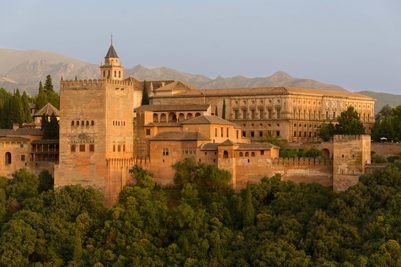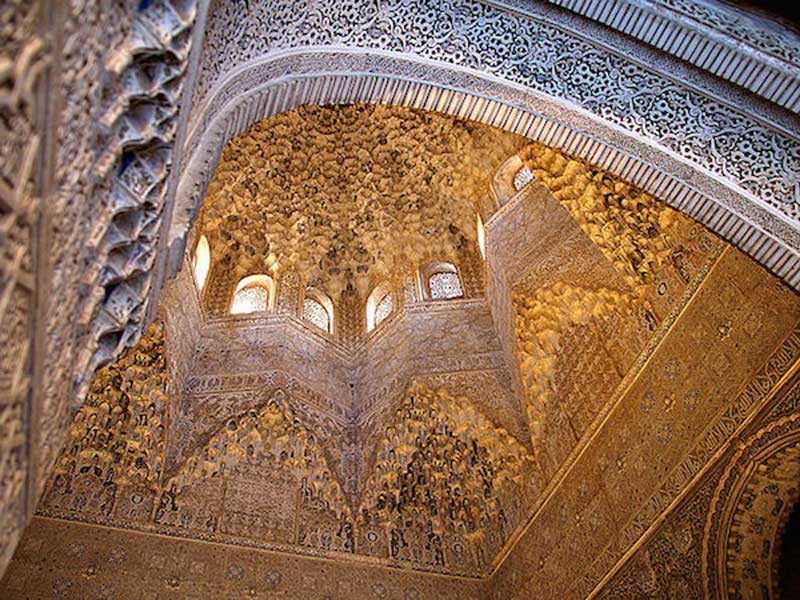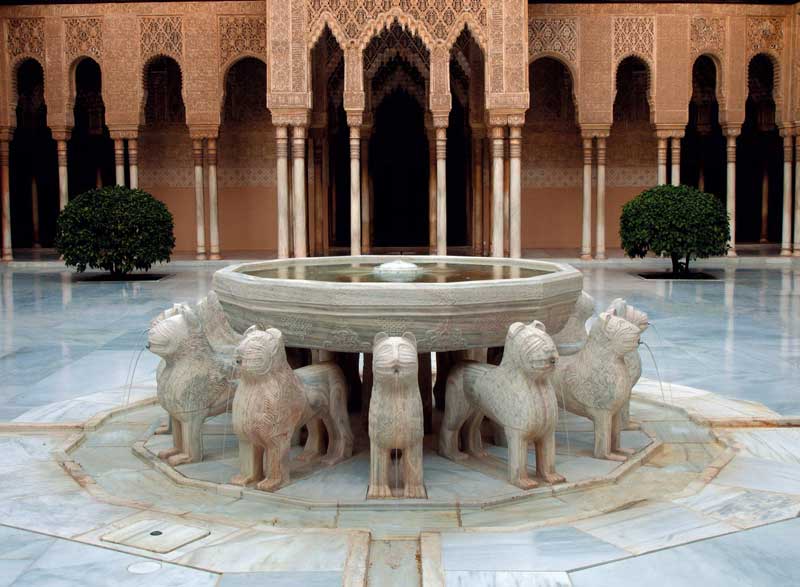
Described by the Moorish poets as a pearl set in emeralds, the Alhambra Palace complex is surrounded by mountains and located on the Sabika Hill, overlooking the city of Granada in Spain, with Generalife Garden situated nearby on the slopes of the Hill of the Sun. Originally constructed as a small fortress in 889 AD, on the remains of a Roman fortification, it was named for the reddish walls and towers that surrounded the citadel.
The Alhambra, an abbreviation of the Arabic Qal’at al-Hamra, or the Red Fort, is the only surviving royal city of the Islamic Golden Age, and the remnant of the last Islamic kingdom in Western Europe.
It is believed that Alcazaba, the oldest part of the Alhambra comprising an ancient fortress with multiple towers, was build before the arrival of the Muslims in Granada. According to the earliest available records, around the year 889, a man named Sawwar ben Humdun sought refuge in the Alcazaba fortress, during the conflict between the Muslims and the Muladies or Muwallads, the Christians converted to Islam. It is considered that Sawwar and his followers may have initiated further constructions at the fortress. However, the Alhambra was largely ignored until 1237, when Abu Abdullah Muhammad ibn Yusuf ibn Nasr, also known as Ibn al-Ahmar, founder of the Nasrid dynasty, secured the region and began to construct his court complex on the Sabika Hill the following year. Subsequently, he settled in the Alcazaba, and the huge complex of the Alhambra, a walled city with thirty towers of varying sizes within a city, was chiefly built between 1238 and 1358, by Ibn al-Ahmar, and his successors.

Much later, after the expulsion of the Moors in 1492, the interior of the Alhambra was changed drastically, when the inscriptions and the furniture were either ruined or removed. Charles I, who ruled Spain during 1516- 1556, destroyed part of the complex to build a Renaissance-style palace for his own use, designed by Pedro Machuca in 1526. He built other structures as well, including the Emperor’s Chambers, the Queen’s Dressing Room, and a church that replaced the Alhambra mosque.
During the Peninsular War, some of the towers of the Alhambra Palace were destroyed by the French force in 1812, while the rest of the building was narrowly saved. The complex was further damaged by an earthquake in 1821. However, Alhambra underwent a long series of repairing and rebuilding during the 19th century, when in 1828 the Spanish King Ferdinand VIII commissioned architect José Contreras for the job that continued even after the death of the architect in 1847 and continued for four decades by his son.

The buildings of the Alhambra comprised three distinct sections which included the citadel, Alcazaba, that housed the guards, responsible for the safety of the complex and their families; the palatial zone containing several palaces for the use of the sultan and his close family members; and the medina, an area near the Puerta del Vino, or the Wine Gate, where the quarters for the court officials were located.
Built on the isolated and precipitous foreland that terminates the plateau on the northwest, the Alcazaba is in ruins except for its massive outer walls. As a symbol of the Spanish conquest on 2 January 1492, the flag of Ferdinand and Isabella had been hoisted on its 85 feet high watchtower. In the 18th century, a turret containing a big bell was added to it which was damaged by lightning in 1881, and subsequently restored.

The Royal Complex, commonly known as the Nasrid Palaces, consists of three independent areas. While modest in décor Patio del Mexuar, or the Court of the Council Chamber was the functional areas for conducting administration, the Comares Palace was the official residence of the sultan, containing several rooms and the elaborately decorated Harem, the living quarters for the wives and concubines of the sultan, equipped with bathrooms open to the elements for light and air. The rooms of the Comares Palace surrounded the 140 feet (43 m) long and 74 feet (23 m) wide Court of the Myrtles, containing a large pond in the centre, set in the marble pavement and full of goldfishes, with green myrtles growing along its sides. The 116 feet (35 m) long and 66 feet (20 m) Court of the Lions, located next to the Comares Palace, is surrounded by a decorated gallery supported by 124 marble columns. The court features a fountain with a complex hydraulic system, equipped with a marble basin on the back of twelve stone lions, emblems of strength and courage. The arched covered patio that encircles the courtyard displays fine stucco carvings held up by a series of slender columns.

The 37 feet long Hall of the Ambassadors, the largest room in the Alhambra, topped with a 75 feet (23 m) high central dome, served as the grand reception room, with the throne of the sultan placed opposite to the entrance. The Hall of the Abencerrajes, with a lofty dome and trellised windows at its base, is a perfect square. The roof of the hall is decorated in blue, brown, red, and gold, while its supporting columns spring out beautifully in the form of arches. The Hall of the Two Sisters, located opposite the Hall of the Abencerrajes, was named after the two large white marble slabs laid as part of the pavement. The dome of the hall, honeycombed with all different tiny cells, around 5,000 in number, is a wonderful example of Moorish stalactite work.


In addition to the above, the Alhambra also includes, among others, Sala de la Justicia, or the Hall of Justice, Patio de Daraxa, or the Court of the Vestibule, Patio del Mexuar, or the Court of the Council Chamber, and the Peinador de la Reins, the Queen’s Dressing Room, built around 1537 at the top of the Abu I-Hayyay’s Tower.
The Alhambra, along with the Palacio de Generalife, or the Garden of the Architect, one of the outlying buildings connected to the Alhambra, was designated a UNESCO World Heritage Site in 1984.